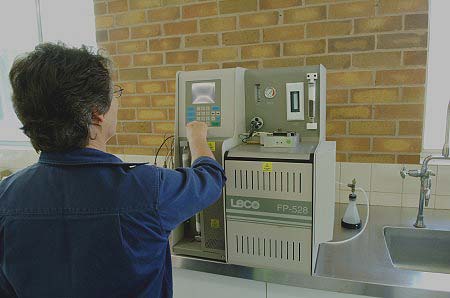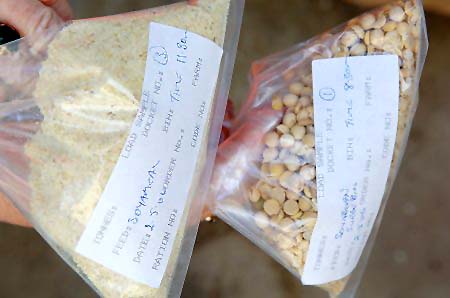Feed Evaluation
Feed Evaluation
Feed evaluation is the testing of feed quality, providing information on the composition of feed or feed ingredients as well as their suitability for poultry. Poultry feed is made up of many ingredients, which are broadly grouped into providers of energy (fats, oils and carbohydrates), protein (amino acids), vitamins, minerals and product quality enhancement. Typically, cereals such as wheat, barley, sorghum and maize will provide energy while soybeans, lupins, canola and peanuts provide protein. These ingredients are then combined in such a way as to provide the energy, protein, vitamin and mineral requirements for poultry through the process of feed formulation. In order to know what amounts of these ingredients should be included in the diet, the ingredients are first evaluated, to see what nutrients they contain in what quantities. After the diet has been prepared, it may also be necessary to evaluate the complete product, to determine its suitability for the class of poultry that will be fed (such as egg layers, meat chickens or breeders).
Feed evaluation is a key process in the poultry industry. Feed ingredients need to be tested in order to formulate the complete diet, and diets have to be evaluated to determine their suitability for poultry. Evaluation provides different types of information, as required by nutritionists and farmers. In general, the range of tests that can now be performed is wide and it is now possible to obtain results rapidly.

Testing feed quality. Image courtesy of ACMF
Measures of feed quality
Feeds and feed ingredients can be evaluated physically as well as chemically. The physical evaluation of feed mostly provides preliminary information on the quality of the material. It involves assessing physical qualities such as weight, colour, smell and whether the material has suffered from any contamination by other materials. Chemically, feed is made up of water and dry matter. The dry matter contains organic and inorganic compounds. The organic part of feed is made of mainly carbohydrates, proteins, vitamins and fats and oils. The inorganic part is made of mineral elements, also known as ash. Feed or feed ingredients can be analysed to provide values of each of these components. Apart from obtaining values of chemical composition, the extent of utilisation of these components by the bird, termed nutritive value, is also measured.
How feed quality is measured
Feed quality is measured by chemically breaking up the food into the components mentioned above. In the industry, it is sometimes necessary to break down these large components into smaller analytical fractions. Thus, values of starch and the non-starch component (called fibre) of carbohydrates may be provided. Proteins are made of amino acids, 10 of which must be present in poultry diets, so their amounts should be indicated during feed evaluation.
In the past, feed evaluation was a cumbersome process, requiring days to complete. However, newer equipment and procedures have been developed, which enable the rapid evaluation of most materials. For example, starch is determined using a ready-to-use kit and protein is rapidly determined on Leco® machines, which eliminate time-consuming digestion of feed with strong acids and reaction of material with acids and bases. Near-infrared reflectance spectroscopy (NIRS) is one of the latest techniques by which feed ingredients can be evaluated with the most minimal preparation of the sample. NIRS provides the capability to rapidly measuring crude protein, fibre, fat, total and digestible amino acids, calcium, total and available phosphorus and also the energy value (ME) of individual ingredients.
Of greater importance in feed evaluation is the response of poultry to particular feeds. This is regarded as the real nutritive value of the feed and must be measured as part of feed evaluation. Nutritive value does not necessarily entail animal growth or egg production. It gives information on how much of each of the fractions in feed, i.e. starch or energy, protein (amino acids), fats, minerals or vitamins, was used by the bird. When feed is given to poultry, they are able to break down only a fraction of the feed and absorb it into the body for growth and egg production. The rest is voided in faeces and urine, which are excreted together by poultry. The amount of nutrients retained by the bird is an indication of the nutritive value of the feed.

Feed samples. Image courtesy of ACMF
Importance of feed evaluation
Feed evaluation is important because ingredients that belong to the same class contain different nutrients; for example, maize provides more energy than wheat while soybeans contain more proteins than lupins and canola. The same ingredient varies from one supplier to the other, and between years. In drought years, cereals fill poorly and are therefore lower in quality. Most importantly, if feeds are not evaluated, it is not possible to tell if the material will be suitable for feeding poultry. Feeding standards have already been set for different types of poultry, so the requirements for different nutrients must be met precisely. It is possible, with the current state of knowledge, to predict poultry growth or egg production by modelling feed quality, type of housing, class of poultry and duration of feeding. The central key issue in these models is feed quality, which can only be obtained through feed evaluation.
Further information
- McDonald, P., Edwards, R. A., Greenhalgh, J. F. D. & Morgan, C. A. (2002). Animal Nutrition, 6th ed. Edinburgh, UK: Pearson Education Ltd.
- Scanes, C. G., Brant, G. & Ensminger, M. E. (2004). Poultry Science, 4th ed. New Jersey, USA: Pearson/Prentice Hall.

